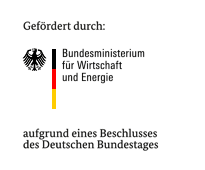Brief description
Solar thermal collectors for the solar heating of domestic hot water and for the support of space heating are mostly mounted on the roof of a building nowadays. However, in order to increase the solar fraction of the heat supply of residential and office buildings, additional areas are needed for solar heat generation. Due to the limited roof area, the facade shall be used for this purpose. The use of the facade area is advantageous, because the monthly solar heat yields better fit to the heat demand of the building. This results in an increase of the solar yield in winter and in a decrease of collector stagnation times in summer compared to the use of the same collector area on the roof.
In the research project „MultiKomp-I“, so-called multifunctional solar building components were developed, i.e. facade elements with integrated solar thermal components, which fulfill the requirements and functions of both the building envelope and a solar thermal system. In other word, the objective was to provide a combination of architectural requirements, such as protection against environmental influences, thermal and noise insulation, and the functionalities of a solar thermal system for domestic hot water preparation and/or space heating in one separate facade element. After the formulation of some basic concepts for such facade-integrated solar thermal systems and the carrying out of comprehensive simulation studies with the help of the simulation software TRNSYS, two prototypes were built up and tested in laboratory environment. Furthermore, one of the prototypes was investigated under quasi-real environmental and operational conditions on an outdoor test facility. Economic and ecological evalluation was also carried out for this prototype.
The research project had the following main contents:
- Development of several basic concepts for multifunctional solar thermal facade elements
- Dynamic building and system simulations of some selected concepts with the simulation software TRNSYS
- Technological development and build-up of two different prototypes
- Investigation of the two prototypes under laboratory conditions
- Outdoor testing of one of the two prototypes
- Economic and ecological evaluation of one of the two prototypes
Selected Results
The first prototype developed and built up during the project is a compact solar thermal facade element for the solar support of domestic hot water preparation. The composition of this prototype is illustrated in the CAD drawing shown below. The main component of this solar thermal facade element is a rectangular, unpressurized hot water store, which is charged directly by the solar radiation passing the transparent thermal insulation in front of the store. That means, the solar radiation, after passing the transparent thermal insulation, reaches the sun-facing wall of the store, heats it up and so finally also heats up the water inside the store. Discharging of the store is carried out via an external heat exchanger.
First of all, the prototype was tested in the dynamic solar simulator at ITW/TZS. These tests demonstrated the basic operational capability of the concept. In particular, the tests showed the suitability of the transparent thermal insulation for the direct solar charging of the hot water store. Further lab tests were carried out with the hot water store in order to determine major heat store parameters, such as the effectively usable store volume, the thermal losses of the store in state of rest (no charging and discharging) as well as the effective vertical thermal conductivity. These tests took place in the store test facility at ITW/TZS.
After the lab tests in the dynamic solar simulator and in the store test facility had been finished, the prototype was integrated into an outdoor test facility (see picture below), in order to investigate the thermal behavior of this facade element under quasi-real environmental and operational conditions. These outdoor tests started in June 2015. An interesting observation of these tests are in particular the significant solar yields in winter, which is due to the favourable, flat angle of the solar radiation on facade plane. Furthermore, no problems turned out as regards to the possible risks of the overheating of certain components in summer and of the freezing of the water inside the store in winter, respectively.
Project Duration
03/2012 - 06/2015
Final Report
The final report with comprehensive information about the project (in German) can be downloaded here.
Acknowledgements
The project "MultiKomp-I" was funded by the German Federal Ministry for Economic Affairs and Energy (BMWi), based on a decision of the German Bundestag by Projektträger Jülich (PTJ) under grant number 0325985A. The authors gratefully thank for the support of the project and take the full responsibility for the content of this publication.
 |
 |
Kontakt

Natalie Bonk, M.Sc.
Academic employee

Dr.-Ing. Harald Drück
Research Coordinator and Team Lead


